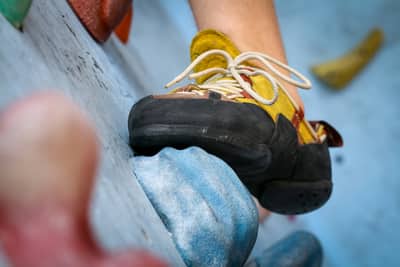When starting out in bouldering, certain issues have a tendency to crop up. Most can be addressed by becoming aware of them and using better techniques instead.
Habits that waste energy include relying on arm strength, climbing with bent arms, over gripping, and overusing dynamic moves. Habits that halt progress include sloppy footwork, holding the body away from the wall, and relying on strength instead of technique.
For faster improvement, replace counterproductive habits with effective alternatives.
1. Relying Too Much on Arm Strength
Problem: Relying on the arms to pull up and hold one’s weight causes early fatigue and rough, jerky movement. It will also slow progression, because stamina and efficiency become increasingly important on higher grades.
Solution: Thrusting upwards from the legs saves upper body strength for when it’s really needed. As a general rule, the arms are best used for positioning and stability, not for pulling up. Develop the habit of using the powerful leg muscles for movement and weight support. When moving up the wall, practice placing the feet first, before placing the hands.
2. Climbing With Bent Arms
Problem: A bent position works the muscles much harder than when the arms are kept straight. Continually using bent arms brings on early fatigue, and can cause “arm pump”, where the forearms become aching and weak from a buildup of lactic acid.
Solution: Keep the arms straight whenever possible. The advantage to keeping the arms straight is that it lets the skeleton take the strain instead of the arm muscles. The weight burden should be taken up by the legs, so make sure it is the legs, and not the arms, that are holding you up.
If you do find yourself with aching, pumped arms, elite climber Eric Horst uses a technique he calls G-Tox to quickly recover while on the wall (1). His technique consists of holding one arm above the head, shaking it for five seconds, then lowering the arm, and again, shaking it for five seconds. Repeat with the other arm. The G-Tox technique gets the blood flowing and flushes out the lactic acid, speeding the return of grip strength (2).
3. Overgripping
Problem: Clutching holds with a death grip causes early fatigue, and the extra friction brings on skin abrasion sooner than if using a lighter grip. Skin chafing may not seem a huge issue, but the pain of raw, tender skin can put an early end to the bouldering session.
Solution: For longer stamina and happier skin, use as light a grip as will do the job, and no tighter.
How much grip is actually needed? Test this out for yourself, on the wall and close to the ground. See how relaxed your grip can be before you start falling off.
Keep in mind that anxiety makes the body more likely to experience fatigue, even with low exertion. We tire more quickly when nervous or anxious; we have more endurance when calm and confident.
Brian Rigby of Climbing.com explains how pre-climb anxiety sets us up for premature fatigue (3). When anxious, the body perceives that we are working harder than we actually are. The stress response burns through our energy stores. If you find that getting on a boulder always triggers a stress response, see my article on how to reduce this response here.
A quick fix to anxiety is slow, deep breathing. Breathing at the rate of about 6 breaths per minute stimulates the vagus nerve, which automatically brings the body into a calmer state.
4. Not Looking Where You Place Your Feet
Problem: Only looking up when climbing means that the feet are not receiving proper attention. The resulting poor footwork and missed footholds cause dysfunctional overreliance on the upper body.
Solution: Spend as much time looking down for footholds as looking up for handholds. Make a point of scanning the wall to your right, to your left, and below, as well as upwards.
Renowned boulderer John Sherman recommends practicing foothold recognition drills, best done on an outdoor rock face (4). Standing on the ground in front of the boulder, quickly point out five footholds, then another five, then another five. The first ones you point to will be large, obvious ledges that are easy to spot. The last ones will likely be small, barely discernible cracks. This drill, done in a fast, timed way, is great for developing an instinct for finding footholds.
5. Placing the Middle of the Foot on Holds
Problem: Using the middle of the foot on holds is problematic because it anchors one’s position and prevents pivoting.
Solution: There are several foot placement alternatives, each provides different advantages.
The toe-in foot position allows swiveling and, as a bonus, provides a few more inches of reach. This position has the foot straight-in to the wall with the toes resting on the hold. However, since only the toes are resting on the hold, the toe-in requires strong calf muscles to support the rest of the foot. For novices, keeping a toe-in for too long can cause the calf muscles to start quivering and weaken from pump-out.
Edging provides more stability than the toe-in. With inside-edging, the inside edge of the shoe’s toe box, from the big toe to the ball of the foot, is resting on the hold. The outside-edge position has the outside edge of the toe box resting on the hold. With both of these foot positions, there will be greater grip and stability when more of the shoe has contact with the hold. Therefore, the foot should be placed at an angle that maximizes the amount of sole touching the hold’s surface.
When taking a quick pause on the wall, a better alternative to using the middle of the foot is to use the heel. Place the heel on a large hold, and keep the leg straight so that it supports your weight.
6. Too Much Readjusting of Hands and Feet on Holds
Problem: Trying to find the perfect hand position by obsessively shifting the grip slows you down, wastes energy, and causes unnecessary skin abrasion. Readjusting foot placement, even just a little, can cause the foot to slip off from the hold.
Solution: Place hands with care, and leave them as they are until starting the next move. Place the feet methodically and carefully the first time, and avoid the temptation to reposition. Take your time with approaching holds. Consider carefully where hands and feet should go before placing them.
7. Ignoring Body Positioning
Problem: Inexperienced climbers approach the climb as they would a ladder, with seat and hips held away from the wall and the body facing straight into the wall. This straight-on, ladder-style position can be appropriate on lightly sloping beginner routes with large jugs. On most bouldering routes, however, this position puts too much distance between body and wall, placing excessive strain on the arms.
Solution: Engage the core and pull the hips into wall-hugging positions when making a move. Hug in closer by twisting hip and shoulder into the wall. Keep the body’s centre of gravity under the holds. With non-vertical body positions, learn to be comfortable with having your centre of gravity in different positions. Learning to lean like this opens up to more advanced moves.
8. Only Doing Problems You Find Easy
Problem: Performance will not progress when only climbing the friendly and familiar. Staying with holds, moves, angles and problems that we are good at may be fun, but it will lead to stagnation.
Solution: To continue improving, it’s important to regularly try grades above one’s level. After successfully sending a difficult problem, it is very helpful to repeat the problem to lock in and hone the beta. Practice until it becomes easy, then it’s time to move on to the next challenge.
Accommodation is where the body has adapted to a certain level of stimulus and there is no more progression on that level of stimulation. Too much repetition can lead to this type of stagnation. Add variety to sessions by varying the difficulty of problems, the amount of effort put into the session, and the level of fatigue at which call it a day.
Occasionally try a different bouldering gym, because setting style and V grade difficulty do vary between different gyms.
9. Putting More Focus on Strength Training Than on Climbing
Problem: Focusing on strength training instead of on bouldering is counter-productive, because relying on strength means that technique is either ignored or neglected.
Solution: For continued improvements in performance, technique should be the first focus. Strength will come naturally with climbing. Too much strength too early on can hamper progress because it results in relying on power instead of refining technique. Muscle development is a slow process, but regular bouldering will eventually pay off in strength gains.
Before using hang boards and campus boards, it’s important to build up tendon resilience. Too much stress too soon leads to tendon injury. It takes up to two years of regular bouldering for tendons to adapt to the demands of the sport.
Another problem with training with hangboards is the time it takes away from bouldering during sessions. Only bouldering will develop bouldering skills and technique. Due to accommodation, elite climbers may need hangboard training to continue gaining strength, but with regular climbers, the time is better spent on actual bouldering.
The advantage to gaining strength through bouldering is that skill and strength will improve in tandem, without neglecting one or the other. When working on actual bouldering problems, yes, the demands will build strength, but at the same time, skill and efficiency are also getting a workout. In contrast, training with weights develops only strength. Top performing boulderers have found this balance, where strength does not eclipse skill and ability.
10. Using Dynamic Moves When Static Moves Will Do
Problem: Leaping and becoming airborne to reach a hold increases risk of injury, especially in the shoulders (1). It relies on strength, rather than skill, and it bankrupts one’s energy stores.
Solution: Occasional dynos are great but should be limited to situations that offer no other option, especially on longer problems or higher grades where stamina needs to last. Eric Horst recommends limiting dynamic lunges to situations where you feel confident of success, where there is no other option, or where doing a static sequence would use more energy than the jump.
Related Questions
How do I make progress every time I practice?
- Always have a plan before jumping on the wall. Study each hold for the best way to approach it. What sort of footwork will be needed? Have you learned any new beta that could be applied here?
- Boulder regularly and give 100% effort on a regular basis. Take instruction classes.
- To make progress, Neil Gresham tells us to focus on the aesthetic side of movement: good form leads to fluidity and efficiency. Practice smooth transitions between holds. The Neil Greshams Masterclass videos on Youtube are an excellent resource, worth checking out.
How do I avoid picking up bad habits right from the start?
- Keep unnecessary shifting and readjusting to a minimum: make every move deliberate and clean.
- Faster movement allows better use of momentum and energy, but speeding up should be avoided until solid footwork and smooth, fluid movement are a normal part of one’s performance.
References
- Eric J Horst, Learning to Climb Indoors. Guilford, Connecticut: FalconGuides.
- https://www.mountainzone.com/blogs/performance_training/2006/07/study-shows-g-tox-accelerates-recovery.html
- https://www.climbing.com/skills/learn-this-the-over-gripping-myth/
- John Sherman, Better Bouldering, 3rd Edition. Guilford, Connecticut: Falcon.

